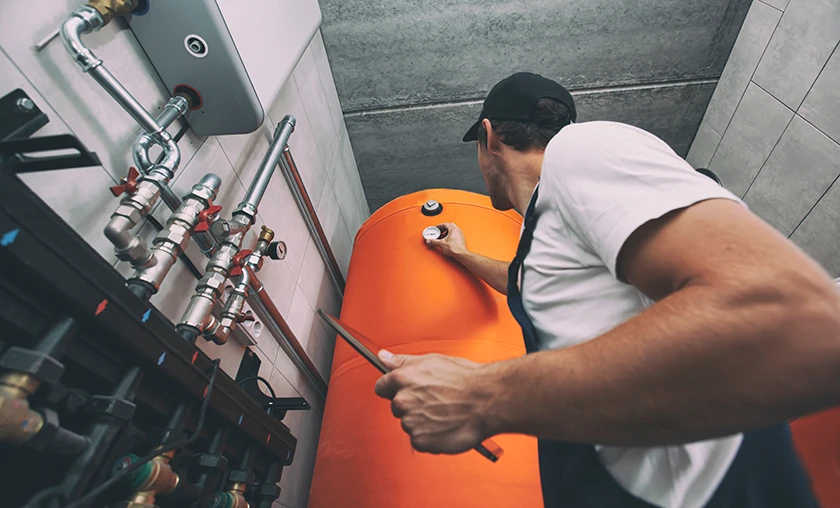High-efficiency, gas-fired heating appliances achieve their efficiency (i.e. over 90 percent AFUE) by extracting heat from exhaust gases, which then creates an acidic residue from condensation inside the appliance. This condensate has a low pH level, usually between 2.9 and 4.0 pH, making it corrosive to building and wastewater infrastructure.
As such, the heating and plumbing industries are gradually recognizing the important role condensate neutralizers play in safeguarding the country’s deteriorating wastewater infrastructure. The current scenario is quite alarming considering the nation’s infrastructure received a “D+” on the 2021 Report Card for America’s Infrastructure from the American Society of Civil Engineers (ASCE). If untreated, the increasing volumes of acidic condensate produced by condensing appliances can further deteriorate our wastewater infrastructure. Condensate neutralizers can help prevent such damage, however.
Recently, plumbing code revisions have addressed this issue by prohibiting the discharge of corrosive wastes or even mandating the treatment of acidic waste before it is released in public wastewater systems. To ensure the efficient treatment of acidic condensate and code compliance, engineers, contractors and service technicians should be sure to select the appropriate condensate neutralizer for a condensing appliance installation. Decision-makers should consider four distinct criteria.

- BTU input of heating appliance and efficiency rating correlates to condensate volume
During the condensing phase, high-efficiency, gas-fired heating devices are designed to produce a certain volume of acidic condensate, which varies based on the BTU input of the appliance and its efficiency rating. Generally, the condensate volume, measured in gallons per hour (GPH), will increase as heating capacity and efficiency increase. However, installers should consult with the heating appliance manufacturer and measure the condensate volume and acidity upon start-up to confirm. - Raw gas composition burned during combustion
The composition of the raw gas burned in a condensing heating appliance may impact the acidity of the condensate produced. Condensate neutralizers are rated to treat the typical acidic condensate, which has a pH level of 2.9 to 4.0 generally. However, more acidic condensate (lower pH) would require additional “soak time” to be sufficiently treated. All things being equal, engineers should specify and installers should select a slightly larger capacity condensate neutralizer to treat highly acidic condensate. Similarly, installers and service technicians should test the pH level of the untreated condensate upon start-up to ensure the appropriate condensate neutralizer sizing. - System design influences condensate neutralizer features
Different types of heating systems (e.g. radiant, hydronic) can influence the condensate volume and thus the condensate neutralizer sizing. Additionally, engineers and contractors should consider specific operating site conditions, such as the location or the height of the heating appliance, which can dictate specific requirements of the condensate neutralizer. For instance, a lower inlet for appliance installations close to the floor. - Heating appliance’s operating hours impact condensate production
Installers and service technicians should consider the heating appliance’s variance of operating hours over a year. Naturally, heating is required for more hours in a day during colder months, which increases the volume of acidic condensate produced. All things being equal, a higher volume of acidic condensate requires sufficient "soak time" with neutralizing media, such as JJM®’s pH Power Pellets®, to ensure effective neutralization. To that end, condensate neutralizer models are purpose-built to neutralize the varying volumes of acidic condensate.

Stay ahead of the curve
Leading designer and manufacturer JJM Alkaline Technologies® offers the largest portfolio of condensate neutralizers for residential and commercial installations. JJM®’s products are purpose-built with distinct features for heating and plumbing installations. To ease the selection process, JJM® rates its products according to BTU capacities, ranging from 125 MBH to 12,000 MBH, and the estimated condensate flow in GPH.
JJM®’s range of solutions can accommodate site-specific requirements or installer preferences, including models with horizontal or vertical orientation, or for wall-mount or floor-mount installations. For example, the K-Series models by JJM® are equipped with one of the lowest inlets on the market and the versatility to install with either hard-pipe or vinyl tubing, making them an ideal solution for most residential and commercial installations.
Selecting and installing the right condensate neutralizer is imperative for efficiently treating acidic condensate. Purpose-built, innovative neutralizing solutions by JJM® are clearly categorized by their capacity and features, which makes it easy for distributors, contractors and service technicians to choose the appropriate add-on for their condensing appliances. For more information about the industry leader in condensate neutralizers, contact JJM Alkaline Technologies® today.